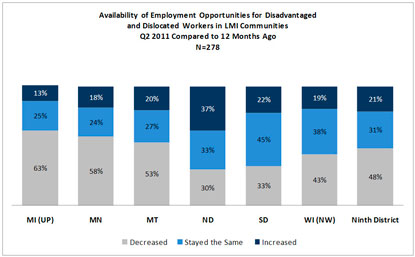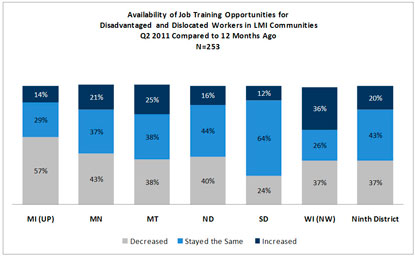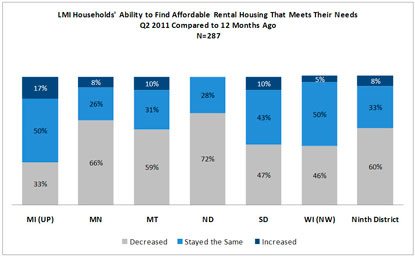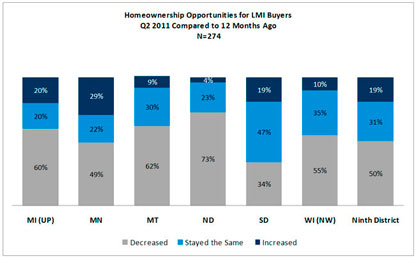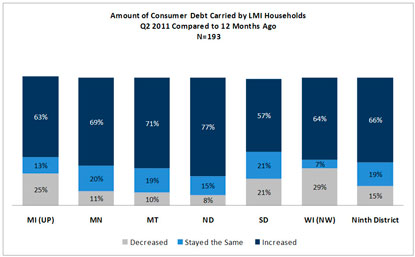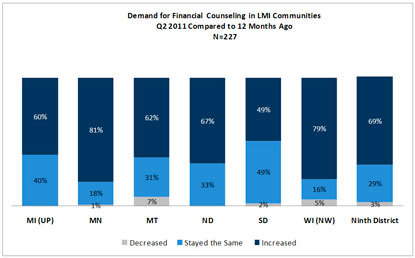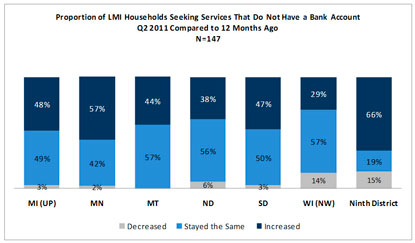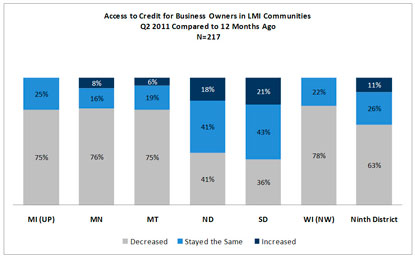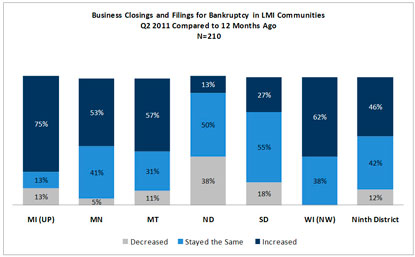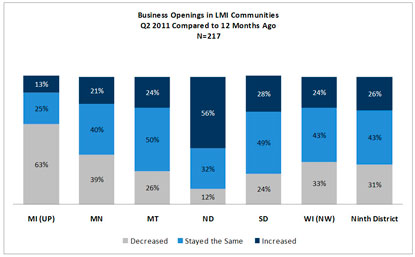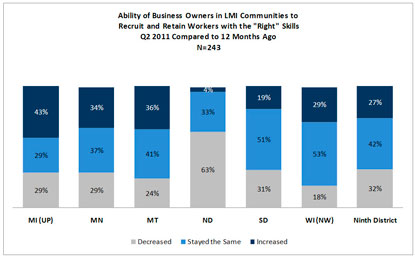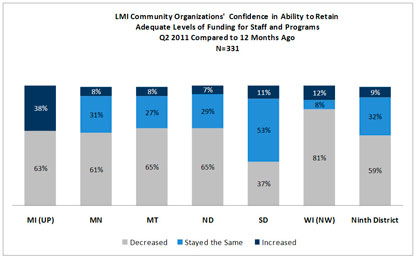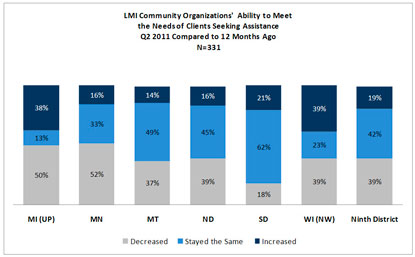Our Mission
The Community Development Department supports the Federal Reserve System’s economic growth objectives by promoting community development through fair, impartial, and efficient access to credit and related financial services. We support investment in low- to moderate-income communities through information, outreach, and technical assistance. We serve the Ninth Federal Reserve District, which includes Minnesota, Montana, North Dakota, South Dakota, northwestern Wisconsin, and the Upper Peninsula of Michigan.
Introduction
This report presents the findings from a survey of community development and service organizations that is designed to provide insight on key indicators related to the economic health of low- to moderate-income (LMI) communities. Information included in this report is based on the front-line observations of representatives of 335 organizations that play a critical role in the development and stabilization of LMI communities in the Ninth Federal Reserve District. Respondents were asked to gauge changes in employment, housing, financial, and business conditions for the communities they serve by comparing current conditions with those that prevailed 12 months earlier. Collectively, their observations help provide a community-based perspective on issues that are important to the community development work of the Federal Reserve Bank of Minneapolis.
Survey respondents included: public and private economic developers; state workforce and job service centers; housing developers and housing service providers, including government agencies; Community Action Agencies and other organizations that provide basic-needs assistance; financial education providers; lenders; small business technical assistance providers; trade associations; tribal organizations; university extension services; community foundations; neighborhood organizations; and other nonprofit entities. The geographic locations of respondents were widely dispersed, representing more than 180 cities and townships across the Ninth District.
State |
Proportion of Respondent Pool |
Proportion of Ninth District Population |
Michigan (UP) |
2% |
3% |
Minnesota |
39% |
60% |
Montana |
18% |
11% |
North Dakota |
9% |
7% |
South Dakota |
23% |
9% |
Wisconsin (NW) |
8% |
10% |
Information for Ninth District Community Insight was gathered through an online survey developed and administered by the Community Development Department of the Federal Reserve Bank of Minneapolis. Responses included in this second quarter report were collected during the months of May and June, 2011. Respondents were asked to gauge changes in LMI community conditions using the response categories “decreased,” “stayed the same,” or “increased.” They were also invited to elaborate on these categories by providing comments. Respondents were instructed to answer questions based on firsthand observations and were encouraged to answer “don’t know” if they were not knowledgeable about an issue in the community. For each question, those who answered “don’t know” were excluded from the analysis. Percentages reported are for valid responses only, unless otherwise noted. Numbers might not equal 100 due to rounding.
LMI Economic Conditions at a Glance
Survey responses indicate that overall economic conditions for LMI communities in the Ninth District have not improved over the past 12 months. Indicators that showed the least improvement Districtwide were:
- Demand for financial counseling in LMI communities;
- LMI households’ ability to find affordable rental housing that meets their needs;
- Access to credit for business owners in LMI communities; and
- Amount of consumer debt carried by LMI households.
LMI Economic Index Second Quarter 2011 |
|||||||
The LMI Economic Index measures overall change in community conditions. The Index ranges from 0 (most deterioration in conditions) to 200 (most improvement in conditions) where a value of 100 equals neutral. A number less than 100 indicates overall deterioration and a number greater than 100 indicates overall improvement. Indicators are ordered from greatest Districtwide deterioration to least Districtwide deterioration based on survey responses. |
|||||||
|
Ninth District |
MI (UP) |
MN |
MT |
ND |
SD |
WI (NW) |
Demand for financial counseling in LMI communities |
34 |
40 |
20 |
45 |
33 |
53 |
26 |
LMI households’ ability to find affordable rental housing that meets their needs |
48 |
84 |
42 |
51 |
28 |
63 |
59 |
Access to credit for business owners in LMI communities |
48 |
25 |
32 |
31 |
77 |
85 |
22 |
Amount of consumer debt carried by LMI households |
49 |
62 |
42 |
39 |
31 |
64 |
65 |
Proportion of LMI households seeking services that do not have a bank account |
49 |
55 |
45 |
56 |
68 |
56 |
85 |
LMI community organizations’ confidence in ability to retain adequate levels of funding for staff and programs |
50 |
75 |
47 |
43 |
42 |
74 |
31 |
Business closings and bankruptcy filings in LMI communities |
66 |
38 |
52 |
54 |
125 |
91 |
38 |
Homeownership opportunities for LMI buyers |
69 |
60 |
80 |
47 |
31 |
85 |
55 |
Employment opportunities for disadvantaged and dislocated workers in LMI communities |
73 |
50 |
60 |
67 |
107 |
89 |
76 |
LMI community organizations’ ability to meet the needs of clients seeking assistance |
80 |
88 |
64 |
77 |
77 |
103 |
100 |
Job training opportunities for disadvantaged and dislocated workers in LMI communities |
83 |
57 |
78 |
87 |
76 |
88 |
99 |
Business openings in LMI communities |
95 |
50 |
82 |
98 |
144 |
104 |
91 |
Ability of business owners in LMI communities to recruit and retain workers with the “right” skills |
95 |
114 |
105 |
112 |
41 |
88 |
111 |
How the LMI Economic Index is calculated |
|||||||
What follows is an in-depth analysis of survey responses, including state-by-state comparisons and illustrative quotes from respondents.
Employment and Job Training
Opportunities for disadvantaged and dislocated workers
More than three-quarters of respondents (79%) said that the availability of employment opportunities for disadvantaged and dislocated workers in LMI communities has either remained the same or decreased over the past 12 months. Several respondents noted that businesses have been slow to hire and that many rural communities have lost jobs due to the exit of manufacturing firms. Districtwide, results indicate some scattered signs of improvement; 1 in 5 respondents said that employment opportunities for disadvantaged and dislocated workers have increased over the past year. According to respondents’ comments, the oil industry in western North Dakota and eastern Montana has provided many job opportunities for men, but few women have directly benefited. Overall, LMI communities in the Dakotas appear to be faring better than those in other states.
“There has been an increase in hiring, but competition [remains] stiff as more qualified workers [restart] the job search process. It also seems that, in this post-Great Recession economy, the opportunities for low-skilled, poorly educated workers [are] even more limited.”—Respondent in urban MN
“Jobs are leaving the area at a rapid pace. Families that may have had two workers are now down to one. Replacement jobs are minimum-wage, which barely meets basic needs. Families typically give up health care and other securities to pay for rent and food.”—Respondent in rural MN
“The oil industry has created many jobs. However, these are primarily male-dominated [occupations]. Few women can obtain or advance in these jobs.”—Respondent in mixed urban-rural ND
Eighty percent of respondents reported that the availability of job training opportunities for dislocated and disadvantaged workers in the LMI communities they serve has either decreased or remained the same over the past 12 months. Several respondents cited decreased federal funding for job training programs as a challenge, while others expressed broader concerns about the development of human capital, including the need for high-quality K-12 programming, more affordable post-secondary education, and accessible pathways to livable-wage jobs.
“Skill [requirements] seem to be higher for new hires. [Unemployment] rates in rural counties are still numbingly high and probably toughest on former manufacturing workers who are not yet ready for retirement.”
—Respondent in rural MI
“The urban Native [American] community remains disconnected from the economic engines of the region. Currently, there is no collective jobs strategy or pipeline that is producing [a pathway] to high-growth, high-demand careers. This lack of strategy results in a continued pattern of low-wage jobs and low rates of homeownership.”
—Respondent in urban MN
“Funding for training dislocated workers through the local Workforce Centers has decreased.”— Respondent in rural MN
Housing
Opportunities for Affordable Rental and Homeownership
More than half (59%) of respondents said that the ability of LMI households to find affordable rental housing that meets their needs has decreased over the past 12 months. According to survey responses, the rise in foreclosures has produced an increased demand for rental housing and lower vacancy rates have led to rising rental costs. LMI renters in Montana and western North Dakota have been particularly challenged by the influx of oil field workers who are willing to pay a much higher price for existing rental units. Across the Ninth District, several respondents noted that the supply of rental housing in their communities has remained flat, while demand continues to increase.
“Our regional housing partnership organization is in the process of dissolving, so it is unlikely there will be much development of affordable housing in our region in the next few years. As state and federal resources have disappeared, the quantity and quality of affordable family housing has also declined.”—Respondent in rural MN
The foreclosure crisis has led to an increased number of homes on the market that are technically affordable to LMI households. However, half of respondents (50%) said that homeownership opportunities for LMI would-be buyers have decreased over the past 12 months. According to respondents’ comments, tighter lending standards and changes to FHA (Federal Housing Administration) loan requirements have precluded some families from purchasing the lower-priced homes that are available. In Indian Country, issues related to land documentation have also been a purchase barrier. Some respondents noted that rising energy costs have made owning a home too expensive for some LMI households, even if they are eligible for a mortgage loan.
It is worth noting that, in some LMI communities across the District, homeownership opportunities for buyers with good credit and sufficient income have increased. Survey results suggest that the outlook for LMI prospective buyers may be more favorable in Minnesota than in other states, as a greater proportion of Minnesota-based respondents (29%) said that affordable homeownership opportunities have increased over the past 12 months.
“While interest rates are low, credit requirements are very tight and this has created new challenges for families wanting to purchase homes. In our county, there have been more than 400 residential foreclosures over the past three years. We are seeing a new trend in homes on the market as well: approximately 70 percent of the units for sale are vacant.”—Respondent in rural MN
“[There are] more homes on the market with lower prices to choose from, but they are of a [low] quality that FHA [Federal Housing Administration] loans won’t support and cost so much to heat they are still not affordable to low- to moderate-income households.”
—Respondent in rural MN
“Housing remains a huge issue [on the reservation]. Low-income [renters] are on housing waiting lists that are one- to three-years long. Home buyers using the HUD [U.S. Department of Housing and Urban Development] 184 program still face land documentation issues with the BIA [Bureau of Indian Affairs] that are cumbersome and extremely lengthy. Long delays in land transactions with the BIA is the single most critical issue [preventing the approval of] mortgages on the reservation.”—Respondent in rural MN
“Affordable housing is at a premium as families who lost their homes to foreclosure have moved into rental housing. One bright spot is that low- to moderate-income families that have maintained good credit have had the opportunity to purchase previously foreclosed homes through the Neighborhood Stabilization Program.”— Respondent in mixed urban-rural MN
Household Financial Well-Being
Consumer debt, financial counseling, and the use of alternative financial services
Two-thirds (66%) of respondents said that, in the LMI communities they serve, the amount of consumer debt households are carrying has increased over the past 12 months. However, a handful of respondents in Minnesota, South Dakota, and Wisconsin said they have witnessed decreases. According to respondents, many LMI consumers are relying on credit to meet basic living expenses. For some LMI households, large debt loads and poor credit ratings have limited their housing opportunities.
The demand for financial counseling in LMI communities also appears to have increased over the past 12 months. More than two-thirds of respondents (69%) reported seeing an increased demand for this service in the communities they serve. Although many LMI households seek counseling because of debt problems, several respondents viewed it as a positive step toward recovery and long-term self-sufficiency. Respondents’ comments suggest that the demand for financial counseling has increased across all racial groups, and that modifications to traditional curricula may be needed in order to meet the needs of very low-income consumers.
Despite a growing demand, the resources available for financial counseling appear to be in decline. A few financial education providers expressed concern about the negative impact that government cuts would have on their programs. Cuts to resources provided by the 2009 American Recovery and Reinvestment Act and the U.S. Department of Housing and Urban Development were mentioned in particular.
“In [our community], financial counseling is much-needed based on the economic challenges of residents in general combined with foreclosures, high unemployment, [and the aftermath of] a recent tornado. The amount of consumer debt that households are carrying has created barriers to homeownership, quality rental housing, and lines of credit. In addition, a large portion of residents are using check cashing institutions and payday loans to meet their needs because they lack trust in banks and [lack] knowledge about the banking system.—Respondent in urban MN
“Our clients need financial counseling; however, the resources for providing this type of training are dwindling.”—Respondent in mixed urban-rural MN
In response to questions about financial well-being, several respondents mentioned LMI households’ use of alternative financial service providers, including payday lenders and check cashing venues. Districtwide, 48 percent of respondents said that the proportion of clients seeking services that do not have a bank account has increased over the past 12 months.
“[The prevalence of] not having a bank account still remains high on reservations. People still tend to use a check cashing venue and pay bills with cash or money orders. We are seeing movement on a few [Indian] reservations to include financial education and counseling as part of their new CDFI [community development financial institution] infrastructure.”—Respondent in rural MN
Business Conditions
Start-ups and closings, access to credit, and the ability to find qualified workers
Nearly two-thirds of respondents (63%) said that, for business owners in LMI communities, the ability to obtain the amount of credit they need has decreased over the past 12 months. According to respondents, obtaining credit has been particularly difficult for start-ups and less established business owners. Responses indicate that gaining access to credit may be less of a challenge for business owners operating in LMI communities in the Dakotas than for those operating in LMI communities in other states. Seventy-five percent or more of respondents in Minnesota, Montana, and northwestern Wisconsin said that business owners’ ability to obtain credit has decreased, compared to less than 42 percent in North Dakota and South Dakota. Survey responses also indicate that CDFIs and other non-mainstream lenders are being used to fill the credit gaps of business owners in some LMI communities.
“Overall, the business climate in North Dakota is positive and credit is generally available for new and existing businesses. However, there are still some concerns for business owners who rely on out-of-state sales for a significant portion of their revenue due to economic problems in other states.”—Respondent in mixed urban-rural ND
“SBA [Small Business Administration] loan activity has decreased which provides [one] indication that credit is tighter now than it was 12 months ago. We are also seeing a slight increase in liquidations and delinquencies.”—Respondent in mixed urban-rural MT
“As a nontraditional lender, our loan volume has doubled because banks have reduced their small business lending. In 2010, we ran out of capital at the end of the first quarter … we hope to not run out of money again [this year].”—Respondent in mixed urban-rural MN
Business vitality in LMI communities appears to vary across the District. Nearly half (46%) of respondents said that the number of businesses closing or filing for bankruptcy has increased over the past 12 months, while 42 percent said that conditions remain about the same. Responses indicate signs of improvement for some LMI communities; about one-quarter of respondents (26%) reported an increase in the number of business openings in the communities they serve compared to the same time last year. In particular, several respondents mentioned an increase in the number of new microbusinesses. Overall, LMI community business conditions appear to be strongest in North Dakota. In addition to comparatively favorable credit conditions, a higher proportion of North Dakota-based respondents indicated an increase in business openings and a decrease in closings than did respondents in other states.
“We saw several small businesses close in the second half of 2010. We have not seen that trend continue in 2011, but we are not seeing many new start-ups either. Existing businesses have expanded their lines of credit, but are still short of where they would like to be.”
—Respondent in urban MN
“Our lack of commercial rental space is holding up several entrepreneurs. Also, banks have tightened up [on lending] … [Some] won’t even take any applications for new business ideas … The city is opening up several acres of undeveloped riverfront this year and we are hopeful that it will help us attract new businesses.”—Respondent in rural SD
In LMI communities across the District, the ability of business owners to recruit and retain workers with the “right” skills appears to vary. Several respondents who serve rural areas experiencing challenges cited population loss as a major influencing factor. Subsequently, these respondents also mentioned the need for more higher-skilled workers that are capable of operating advanced machinery. Survey responses suggest that businesses based in LMI communities in North Dakota may be experiencing more difficulty with worker retention than their counterparts in other states. North Dakota-based respondents were two times more likely to report a decrease in employers’ ability to recruit and retain qualified workers over the past 12 months. According to respondents’ comments, the inability to compete with oil-field wages has created a challenge for professional and service industry businesses alike.
“Businesses are having difficulty recruiting [both] professional and retail-and-service workers. In the western part of North Dakota, many local residents have left long-time jobs for work in the oil fields because the salaries are so high.”—Respondent in mixed urban-rural ND
Capacity of Community Development and Service Organizations
Funding levels and the ability to meet LMI community service needs
In addition to sharing their perspectives on current economic conditions for the LMI communities they serve, we asked respondents to share their perspectives on their own organization’s financial outlook and ability to meet ongoing community service needs.
Districtwide, more than half (59%) of respondents reported decreased confidence, compared to 12 months ago, in their organization’s ability to retain adequate levels of funding for staff and programs. Survey responses indicate widespread concern about cuts to government funding. From Community Action Agencies to small business technical assistance providers, many respondents expect federal and state funding cuts to have a negative impact on service delivery in LMI communities. In particular, several respondents mentioned the loss of funds provided by the 2009 American Recovery and Reinvestment Act. Some respondents also noted a decline in foundation support for community development organizations due to shifts in funding priorities.
Survey results suggest that the overall financial outlook for community development and service organizations in South Dakota is more positive than that for organizations in other states. Just 37 percent of South Dakota-based respondents said that their organization’s confidence in the ability to retain adequate levels of funding has decreased over the past 12 months.
“With the federal funding decreases, our [capacity has] declined and we are not able to assist as many businesses that would be hiring low- to moderate-income employees.”—Respondent in rural MT
“Most notably, resources needed to conduct foreclosure counseling have decreased significantly. Funds for energy conservation programs and for basic-needs services are also expected to decrease. This is occurring at a time when economic recovery has not yet arrived and service [demand] is 30 percent higher than it was in 2008. In addition, other organizations with which we coordinate services are also experiencing similar or greater reductions.”—Respondent in rural MN
“Traditional funders and financial institutions serving the community development sector are constraining their resources based on [their] new areas of focus (education). At the same time, community development organizations are starting to seek new ways of doing business, including more partnerships and collaboration to provide services to their constituents.”—Respondent in urban MN
“Many [service] organizations feel that, despite great prosperity in North Dakota, little is being done for those with which they are concerned. In addition, the nonprofit sector in North Dakota is struggling to meet demand with few foundations to support the work.”—Respondent in mixed urban-rural ND
More than one-third (39%) of respondents said their organization’s ability to meet the needs of LMI clients seeking assistance has declined in comparison to 12 months ago. According to respondents’ comments, increased demand for services coupled with decreased funding has resulted in service gaps. In some communities, demographic shifts in the population seeking services have also affected organizations’ ability to meet LMI community service needs. According to respondents, these client changes include more formerly middle class households and more immigrant households.
Survey responses suggest that Minnesota organizations are experiencing greater difficulty in meeting the needs of the LMI communities they serve than are organizations based in other states, as a greater proportion of Minnesota-based respondents (52%) indicated a decrease in their ability to meet needs of clients seeking services over the past 12 months. According to respondents’ comments, some organizations that have increased their capacity to serve over the past 12 months have done so through increased partnership or mergers with similar organizations. It is worth noting that the overall decline in organizations’ ability to meet LMI community service needs is much less than the overall decline in confidence in their ability to retain adequate levels of funding.
“[Last quarter] when the waiting list for the Housing Choice Voucher program opened, we received 4,000 requests for applications in three days. Funding for federal housing programs was decreased in 2011 and an additional decline in revenues is expected in 2012.”—Respondent in mixed urban-rural MN
“We are seeing more people needing assistance as our funding continues to decrease. This is especially worrisome for our area because people [here] do not have nearly as many options for seeking assistance as [do those living in] metro areas.”—Respondent in rural MN
“We are seeing a loss of funding for nonprofits at all levels at the same time needs are increasing. We also are seeing groups looking at mergers, going out of business, and laying off staff or cutting back on programs. There [has been] some increased optimism in the past few months, but people are very cautious and many are concerned about the future.”—Respondent in mixed urban-rural MN
About Ninth District Community Insight
The Ninth District Community Insight Survey is designed to capture front-line observations about issues that affect the economic health of LMI communities. The survey responses can serve as leading indicators of change in conditions that are otherwise difficult to measure, or are not measured through other existing data sources. Federal Reserve Bank of Minneapolis senior leadership and Community Development staff use Ninth District Community Insight to help identify regulatory and policy issues that deserve attention and to decide how Community Development program resources should be targeted. We hope the community-based perspective that Ninth District Community Insight provides will also be a valuable resource for decision makers outside the Federal Reserve System.
Participation in Ninth District Community Insight is entirely voluntary and no individually identifiable information is reported. If you would like your organization to be considered for inclusion in the next survey, contact Ela Rausch at ela.rausch@mpls.frb.org.


